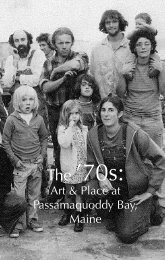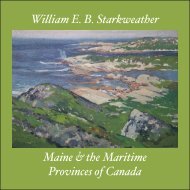Eastport Architecture Book
Featuring nearly 200 large format black and white photographs and six brief thematic essays, this book was published jointly in 2018 by the Tides Institute & Museum of Art of Eastport, Maine and Anchorage Press of Jolicure, New Brunswick. The book examines the architecture of Eastport, Maine within the broader context of landscape and community. The book is a result of a nine year collaboration between photographer, Thaddeus Holownia, and architect, John Leroux. The 216 page hardcover printed version of the book can be purchased from the Tides Institute & Museum of Art and Anchorage Press.
Featuring nearly 200 large format black and white photographs and six brief thematic essays, this book was published jointly in 2018 by the Tides Institute & Museum of Art of Eastport, Maine and Anchorage Press of Jolicure, New Brunswick. The book examines the architecture of Eastport, Maine within the broader context of landscape and community. The book is a result of a nine year collaboration between photographer, Thaddeus Holownia, and architect, John Leroux. The 216 page hardcover printed version of the book can be purchased from the Tides Institute & Museum of Art and Anchorage Press.
You also want an ePaper? Increase the reach of your titles
YUMPU automatically turns print PDFs into web optimized ePapers that Google loves.
There’s no denying that change hit <strong>Eastport</strong> hard over the course of the<br />
twentieth century. Significant losses of jobs and opportunity scourged<br />
this city, which boasted over five thousand citizens in 1900. Each<br />
subsequent decade saw a decline of around five hundred people until the<br />
population leveled off in the 1970s. Cities aren’t designed to function if their<br />
population dwindles by two thirds, but <strong>Eastport</strong> had a solid foundation that<br />
allowed it to press on. Though they certainly didn’t anticipate such downswings,<br />
<strong>Eastport</strong>’s nineteenth-century builders and patrons handed this island<br />
community a collection of civic monuments, emblematic of shared sensibilities,<br />
that have given it the means to sustain fundamental transformation in the<br />
twenty-first century.<br />
One of <strong>Eastport</strong>’s great advantages is its commercial core along Water<br />
Street, a five-block stretch of surviving commercial buildings, listed since 1982<br />
on the National Register of Historic Places. Designed with a stoic elegance that<br />
wouldn’t be out of place in an Edward Hopper painting, these two- and threestory<br />
brick and wood buildings would be the envy of any Main Street in America.<br />
While lack of post-war development and urban renewal may have left<br />
<strong>Eastport</strong>ers feeling out of the loop, the absence in this city of the demolition<br />
that elsewhere accompanied modernization and ‘progress’ turned out to be a<br />
godsend. I think of this every time I pass the venerable local library, still very<br />
much in use, its decorated brick entry arch welcoming you like a much-loved<br />
family member.<br />
This is not to say that <strong>Eastport</strong> has been without losses. While its many<br />
churches are gems of period architecture, one can’t help but grieve when<br />
looking at photographs of the gorgeous Unitarian Church, for instance, that<br />
succumbed to flames in 1946. The sardine and pearl-essence plants that were<br />
unceremoniously demolished or destroyed in recent times would be the envy of<br />
any New England waterfront today. These losses make it that much more crucial<br />
to protect the built heritage of <strong>Eastport</strong> that remains.<br />
A downtown facade-improvement program has been led by the Tides<br />
Institute, resulting in the return of many of the late nineteenth-century brick<br />
buildings to their original forms. Historic structures like the North Baptist Church<br />
and Norwood House are being carefully restored, and efforts to repurpose<br />
others are either successfully completed or gaining traction. Take, for example,<br />
the <strong>Eastport</strong> Arts Center, the Congregational Church, the Old <strong>Eastport</strong> Savings<br />
Bank, the <strong>Eastport</strong> Nursing Home, and the Barracks Museum. In an era when the<br />
massive textile mills of Lowell, Massachusetts, are becoming valuable office and<br />
residential developments, and the obsolete elevated-rail system in Manhattan<br />
can transform into the hugely successful High Line, one has high hopes for the<br />
abandoned can factory downtown on <strong>Eastport</strong>’s Sea Street, one of the last and<br />
most visible reminders of the region’s sardine industry. A refurbishment of its<br />
tenacious brick shell, concrete deck, and post-and-beam structure could drive a<br />
broader waterfront architectural project that would make any port city proud.<br />
It may seem small at first, but the spark effect of a new business infusion or an<br />
owner restoring a property is enormous. The current rejuvenation of <strong>Eastport</strong>’s<br />
downtown has been more than successful, with new restaurants, a pet store, a<br />
bakery, storefront artist studios, and even a candy store cropping up alongside<br />
<strong>Eastport</strong> stalwarts like the Waco Diner, which has stood on Water Street since<br />
1924, and S.L. Wadsworth & Son, the ‘nation’s oldest ship chandlery’, which<br />
has been there since 1818. On a larger, industrial scale, there’s optimism for the<br />
shipping industry and cargo port on the west side of the island. The 1930s vision<br />
of tidal power has also been newly revisited. The lobstering industry and salmon<br />
aquaculture are thriving, and there’s been a noticeable upsurge in tourism and<br />
arts-related attractions. Just ask the many thousands who make the pilgrimage<br />
to <strong>Eastport</strong> every year for the July Fourth celebration or the September Pirate<br />
Festival. These success stories deserve place alongside that of the nationallyrenowned,<br />
heavy-timbered Raye’s Mustard mill, whose original millstones have<br />
ground mustard seeds for over a century now.<br />
The average age in <strong>Eastport</strong> is older than in many places in America, yet<br />
young families are coming and staying. Though their numbers are a fraction<br />
of those of a century ago, many locals still work in the port, in fisheries, and in<br />
boat repair. As well, numerous artists and craftspeople of the early 1970s who<br />
‘discovered’ <strong>Eastport</strong> as a safe, creative haven set apart from big-city America<br />
have stayed put. The citizens who’ve left have done so out of perceived necessity<br />
more often than not, but those who’ve remained, like the newcomers who’ve<br />
lingered, have made it clear that this is where they belong. – J.L.<br />
61






